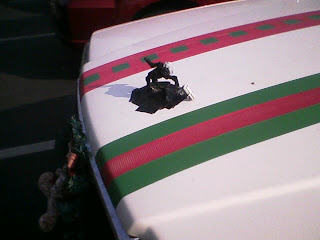On several occasions, my daughter has commented that I sometimes fix things by taking out parts.
A few weeks ago, my daughter asked me about what causes dryers to take too long to dry. It seems the dryer where she lives take more than 80 minutes to dry a load. I offered some of the easier things to check and she tried these, but none helped. So, when we visited last weekend, I brought along an old shop coat.
Looking behind the dryer, I saw a standard flexible vent hose, but, it looked a bit too long to me and it made several turns before attaching to the vent connection. (Sorry, no before photos.) My friend Jim recently told me about how he solved a dryer problem by shortening the vent hose, so I decided to try his idea.
I put on the shop coat, climbed behind the dryer, and we performed a vent-tube-ectomy. This shows the left over bit. Not much really, a bit more than two feet of length.

We also removed a small amount a lint and then reconnected the newly shorted vent tube. The result, fewer turns as shown here.

Then we ate pie.
The following day, I got a call. The results were in, dry times are now under 40 minutes.
So it seems that my daughter was right. I took a part out, put it back together, and now it works better.
Rick

 Here is a close up.
Here is a close up.





 I think it works by filling in the small gaps that tend to occur between the lid and the can.
I think it works by filling in the small gaps that tend to occur between the lid and the can.




 Repeat as needed.
Repeat as needed.


